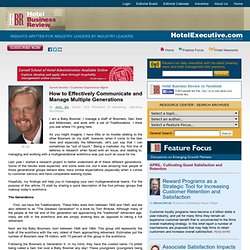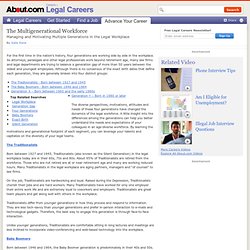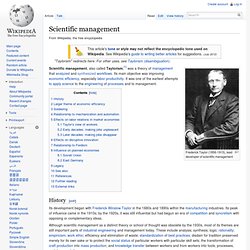

Comment manager une équipe intergénérationnelle. Dans le cadre d’une entreprise, il existe des points de divergences entre les seniors, les jeunes et les : besoin de reconnaissance, investissement dans le travail ou place de la vie privée.

Ainsi, des conflits peuvent souvent apparaître entre les générations. C’est le manager qui doit apprendre à gérer différemment ses équipes. Voici quelques conseils à suivre pour manager une équipe intergénérationnelle : Www.aliaconseil.com/File/bulletin/avril_2005.pdf. Comment manager une équipe intergénérationnelle ? : Comment manager une équipe intergénérationnelle. L’orientation au travail des générations : le cas de la génération X au Québec. 1Les discours sur la jeunesse laissent souvent entendre que les valeurs des jeunes se distinguent de celles des générations précédentes.

Ces discours sont particulièrement fréquents lorsqu’il s’agit du rapport que les jeunes entretiennent avec le travail. On les accuse régulièrement de ne pas vouloir travailler, d’être peu consciencieux et d’être plus attachés au salaire qu’à l’entreprise qui les embauche. L’époque actuelle ne fait pas exception. Les discours du moment laissent entendre que les jeunes, habitués de tout avoir sans effort, ne seraient pas disposés à accepter autant de contraintes que leurs prédécesseurs et seraient prêts à tout abandonner si leurs besoins ne sont pas satisfaits (Allain, 2008). 2Dans les années 1980 et au début des années 1990, c’était le rapport au travail des derniers-nés du baby-boom qui suscitait de multiples interrogations. 4Au Québec et au Canada, les discours entourant cette cohorte de jeunes n’étaient pas véritablement différents.
Www.desjardinsassurancevie.com/fr/evenements-vie/Documents/Réussir à diriger toutes les générations.pdf. How to Effectively Communicate and Manage Multiple Generations, by John Ely. Mr.

Ely Guest Service / Customer Experience Mgmt By John Ely, Senior Vice President of Marketing, Signature Worldwide I am a Baby Boomer. I manage a staff of Boomers, Gen Xers and Millennials, and work with a set of Traditionalists. As you might imagine, I have little or no trouble relating to the other Boomers on my staff, however, when it come to the Gen Xers and especially the Millennials, let's just say that I can sometimes be "out of touch. " Last year I started a research project to better understand all of these different generations.
Hopefully, my findings will help you in managing your own multigenerational teams. The Generations First, we have the Traditionalists. Next are the Baby Boomers, born between 1946 and 1964. Following the Boomers is Generation X. Finally, we have the Millennials. Characteristics As you might expect, the personality characteristics and communication styles between the generations are quite different.
Www.belloaks.com/media/BAhbBlsHOgZmIk4yMDExLzEyLzE0LzE1XzM2XzAyXzYxMF85XzEwXzA4X0JPX0J1c2luZXNzX0ZvcnVtX0dlbmVyYXRpb25zX0F0X1dvcmsucGRm. The Multigenerational Workforce - Managing and Motivating a Multigenerational Workforce. For the first time in the nation’s history, four generations are working side by side in the workplace.

As attorneys, paralegals and other legal professionals work beyond retirement age, many law firms and legal departments are trying to balance a generation gap of more than 50 years between the oldest and youngest employees. Although there is no consensus of the exact birth dates that define each generation, they are generally broken into four distinct groups: The diverse perspectives, motivations, attitudes and needs of these four generations have changed the dynamics of the legal workforce. A little insight into the differences among the generations can help you better understand the needs and expectations of your colleagues in an age-diverse workforce.
By learning the motivations and generational footprint of each segment, you can leverage your talents and capitalize on the diversity of your legal teams. The Traditionalists On the job, Traditionalists are hardworking and loyal. Scientific management. Frederick Taylor (1856-1915), lead developer of scientific management Scientific management, also called Taylorism,[1] was a theory of management that analyzed and synthesized workflows.

Its main objective was improving economic efficiency, especially labor productivity. It was one of the earliest attempts to apply science to the engineering of processes and to management. History[edit] Its development began with Frederick Winslow Taylor in the 1880s and 1890s within the manufacturing industries. Although scientific management as a distinct theory or school of thought was obsolete by the 1930s, most of its themes are still important parts of industrial engineering and management today. Www.ngenperformance.com/pdf/white/ManagingGenDivide.Overview.pdf. What are Traditionalists, Baby Boomers, Generation X, Generation Y, Post Millennials. Helping companies to leverage the power of diverse teams to improve the bottom line.

Culture Coach International Helping Companies to Utilize Diversity as a Strategic Lever for Growth and Innovation Check Out CCI's New Animated Short Film on How To Better Understand Gen Y Gen Y. Www.brown.edu/Administration/Provost/Advance/Trower Generations and Mentoring.pdf. Untitled Document. The Traditional Generation [Born 1922–1945] The Traditional Generation—also known as Veterans, the Silent Generation and the Greatest Generation—comprises employees and retirees born between 1922 and 1943 who are continuing to lead and/or contribute to organizations or are re-entering the workforce.

These older Americans hold three-quarters of the nation’s wealth and are the executive leaders of some of the most established and influential companies in America. This group not only survived the Great Depression of the 1930s but was instrumental in shaping the United States as an economic and military power. Patriotism, teamwork, “doing more with less” and a task-orientation very much define this generation. Www.un.org/staffdevelopment/pdf/Designing Recruitment, Selection & Talent Management Model tailored to meet UNJSPF's Business Development Needs.pdf.